In the first part of this series of articles (see here), about whether the repairs Highland and Islands Enterprise (HIE) has planned for the funicular will work, the following picture was thought to be that of a pier base.
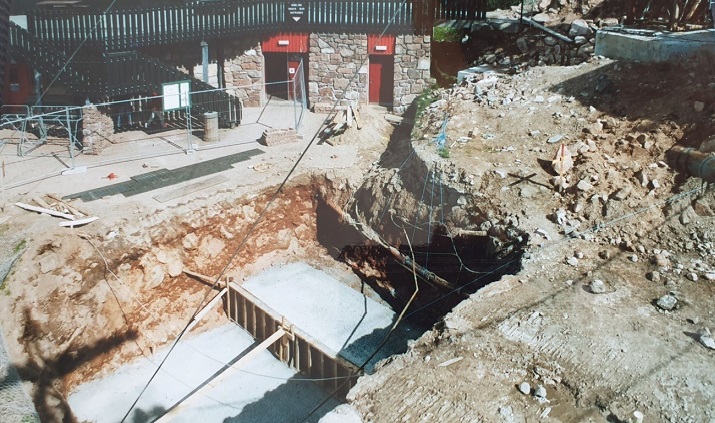
Photo credit. G.Paton.
It is now believed to be that of Anchor Block(AB) 48. Notice there are no steel reinforcing rods cast into the foundations on which the Anchor Block would have been constructed. In the COWI report (see here) it is assumed that the Anchor Blocks are held in place by rock bolts or studs. An example is shown in the next picture:-

A hole is drilled into the concrete base, the anchor bolt/stud is put in the hole and as the nut is tightened, it expands the collar which locks the bolt/stud in place. Smaller versions of this are used by many D.I.Y’ers around the home.
Although this is only one type of bolt, other types could have been used which would have been concreted into holes drilled in the base foundation, with nuts and washers placed on top and tightened to hold the Anchor Blocks in place.
“Some rock bolts at anchor blocks can be loosened by hand. [New observation by COWI/ADAC, Aug 2018] (Page 11, para 2.2.7). The next picture, courtesy of the COWI report (page 13) is of one of those anchor bolts.
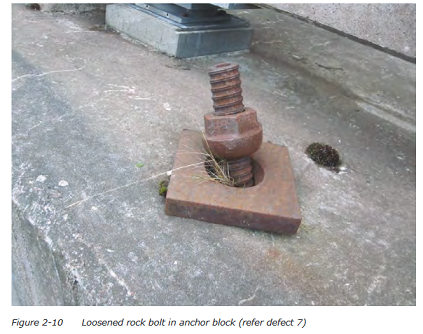
Question (1) Where was the routine maintenance schedule that should have been carried out by maintenance staff that allowed this to happen?
Question (2) Is it possible to tighten this bolt taking into account the corrosion on the threads?
It is not known which of the Anchor Blocks this is, or how many of its securing bolts were loose, but these bolts are there for a reason. These Anchor Blocks take the weight/ strain of the approx. 2 x 300m of uphill concrete beams, which are continually trying to slide downhill under the force of gravity. They should be checked on a regular basis and the nuts torqued to a specific setting. Depending on how many of the bolts on any one Anchor Block were loose, the one below it could have been carrying the full weight of 600m of track! You can see from the corrosion on the rock bolt that the nut has been loose for some time.
Question (3) Why was this not noticed at previous inspections?
Under Para 6 Conclusions and Recommendations of the COWI report (page 311):
“Poor workmanship appears to have been consistent throughout the build and subsequent maintenance”.
As part of the production of the COWI report several test pits were excavated .The next drawing is of the test pit at pier 72.
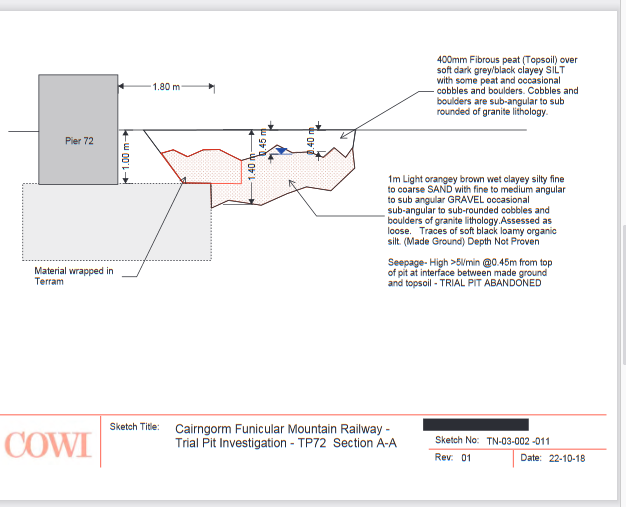
Sketch courtesy of the COWI report Page 201.
Looking at the sketch it shows that the pier is offset on its base. It is not the only one. I would assume that for maximum effect the weight of a pier should be dead centre on its base. Unless the weight is evenly distributed there could be an overturning motion on the base end with the heaviest weight on it which could help explain why they now need propping up.
Question (4) Was this offset positioning of the piers deliberate or was it due to inaccurate surveying either when the foundations were laid or the piers erected? While I have been told by an engineer that it may not be a really a major problem, without the original plans and calculations, which my last post show appear to have been lost, it is difficult to see how one can be certain about this. (I will return to factors which might impact on pier stability in a further post).
The COWI report also states that test pit 72 was abandoned due to high water seepage, presumably from the spring above the pier. It is also not the only pier with a natural spring above it, pier 41 is the same.
Question (5) Has this water seepage been washing out the ground material from underneath the piers? We don’t know the answers to this because, according to Highlands and Islands Enterprise ( HIE), no investigation of the ground beneath the pier bases has been carried out.
COWI report page 192 shows pier 57 was even further out of alignment with its base edge being 2.15m from the corresponding edge of the foundations. If reinforcing bars had been cast into the foundations of this pier they would have been so far out of place when the pier was cast that they would have been totally ineffective! The COWI report has assumed that the anchor blocks are anchored with rock bolts and it looks as though therefore that the piers are anchored in the same way.
The next four pictures, again from the COWI report, three from pages 277/8 and the fourth from page11, show the in situ joint of pier 9 in what appears to be very poor condition with numerous cracks and damage. The first three are from the outside of the structure, the fourth from the inside!
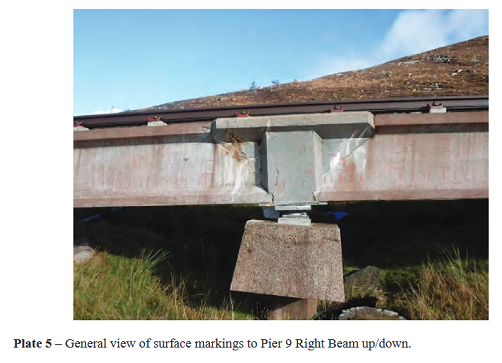
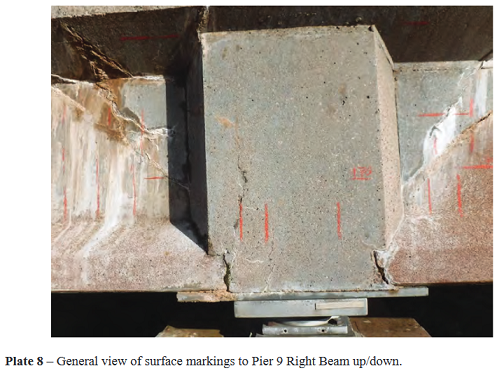

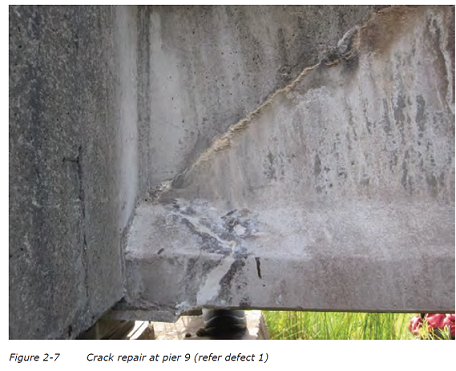
Question (6) If this is the kind of damage that has occurred in 18 years, unless that joint is completely recast , then how much longer will it survive?
Question (7) Has the reason for such extensive damage been investigated?
It is not clear from HIE’s business case what repair work, apart from pier propping – which is in the public realm because it required planning permission – will be undertaken by Balfour Beatty
So far as I know, too, information has not been released by HIE as to why the engineers think that the failure of the Funicular has been so catastrophic.The work that HIE has asked Balfour Beatty at a cost of £16m appears to be about repairing and strengthening funicular up and running again as soon as possible without any investigation of what has caused the problems or the consequences of all the propping, e.g what impact the new structures will have on snow retention.
In my next post, I will attempt to show how these problems may have occurred, why the repairs will not work long term without other repairs and why the funicular should be scrapped now before more money is wasted on HIE’s folly.

Having studied various aspects of structural design & engineering as part of my qualifications at Uni, I have at least some understanding of the basics. Some of what I am about to write I previously stated at those first couple of public meetings that the AGM [Aviemore and Glenmore] Trust held in the two hotels in Aviemore a couple of years back.
1. The fact that the piers &/or the foundations are leaning in to the hill means that the most downhill side of the pier & or foundation is rotating out from the hill slope due to the weight of the track/train putting more force & pressing down on the uphill part of pier & or foundation.
2. This also proves that the foundations & or piers are NOT connected/anchored to any solid bedrock or suitable subsoil.
3. Solid subsoil/bedrock SHOULD have had long (say 3ft to 6ft) metal rods fixed into it & left at least 1ft sticking out, then the foundations should have been poured, encasing these rods. This would have anchored the foundations properly & then the foundations can have holes drilled & anchor rods bolted in for the piers, or anchor rods could have been placed beforehand when the foundations were poured. (the above methods are common & known about). Joint lines between different layers of construction should be bridged across with connectors, where movement/slippage could occur!!
4. ANY joint lines between pre-cast & in-situ cast concrete on the track should have been made movement joints as it is well known that this is a weak spot in engineering & movement will occur (so go with it or design that joint out).
5. The fact that COWI had to abandon the test pit due to excessive water seepage, again proves what is known as the basic subsoil conditions (wet), & again proves that the design & build of the track/piers is NOT fit for the ground conditions.
6. One other condition which is difficult to explain, is that the train actively “hammers” in those piers (on the steeper slopes) as it passes over each one. This due to the way the structural load is applied to the piers as the train passes from uphill to downhill, i.e. the way the load is passed off on to the next downhill pier.
I could go on, but the whole funicular is a bloody awful mess & should never have been built in the first place.
Just read the COWI report…..which proves most of what I have stated just by looking at the structures!….Quite a few of the piers, beams etc are actually overloaded & do not meet the design requirements at the time of design! …The best bit is on page 51/52 of the report where it states:- “the structure has failed to meet the appraisal both for In operation & Out of operation loading”. It goes on to say:- “The superstructure does not comply with strength criteria of BD 44/15. Failures are noted in hog bending at anchorages, & shear in numerous spans in the structure for both In operation & Out of operation loading. The hog bending failure is slightly more critical than the shear failure – to comply with BD 44/15 the carriage load would have to be limited to 30 persons to avoid bending failure which is more onerous than the limit of 50 persons to avoid shear failure”….CGML [Cairngorm Mountain Ltd] has repeatedly run the train at 100 persons per carriage,, which makes the whole track in an OVERLOADED state!..No wonder the track/piers are sliding down the hill & cracking/falling apart!!
Some excellent reporting and commenting by Graham and David. As a former Chartered Building Surveyor I have some experience of how concrete structures should be constructed and how they behave. What I am reading here should be ringing alarm bells for the designers, contractors, HIE and the Scottish government which is about to waste millions of pounds of taxpayers’ money.
It doesn’t take an expert to understand that any structure on a hill will be affected by the force of gravity and if ground water is lubricating the foundations of that structure then it’s hardly surprising that it has moved downwards.
I believe that when the funicular was first conceived, there was strong engineering advice that if it had to be built, then it should NOT be constructed above ground. Stop the repairs now and put the money towards removing the funicular and invest in new uplift for skiers and boarders.
Ayrshire Lad. Some of your comments are already being looked into as from several conversations with various people Nick and I are now beginning to understand the many factors that have contributed to the Funicular failure. Unfortunately we are only two people and opinions by contributors to Parkswatch will only be treated with disdain by HIE. What is needed is for the Scottish Government to requisition an independent survey into the failure. I don’t know if you read the post”A Plan for the future of Snowsports on Cairngorm” from 23/01/2020 but the best option is to install new uplift first allowing CMSL to start an economic recovery and then remove the Funicular at a later date. Again, thanks for your comment.
I recall a couple of years ago, when snow prevented the funicular from running (I know, I know..) that someone posted a ‘for sale, buyer collects, one funicular’ spoof advert on social media. He was told to take down the post, and threatened with legal action. Possibly on the grounds that the post was damaging to the company’s reputation (I know, I know..). I bet they are kicking themselves now that they didnt get any offers……